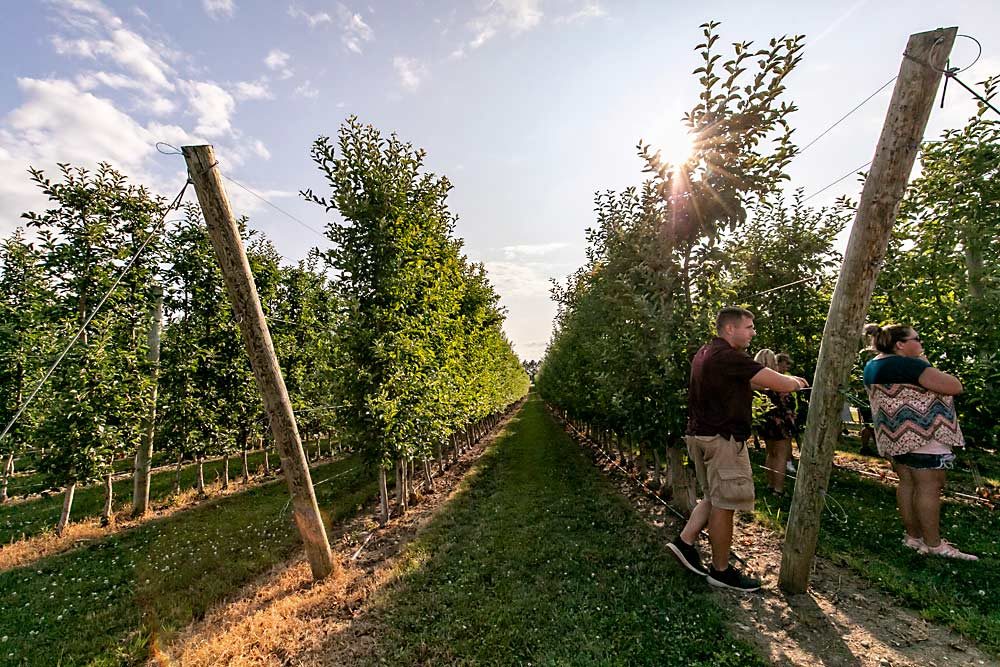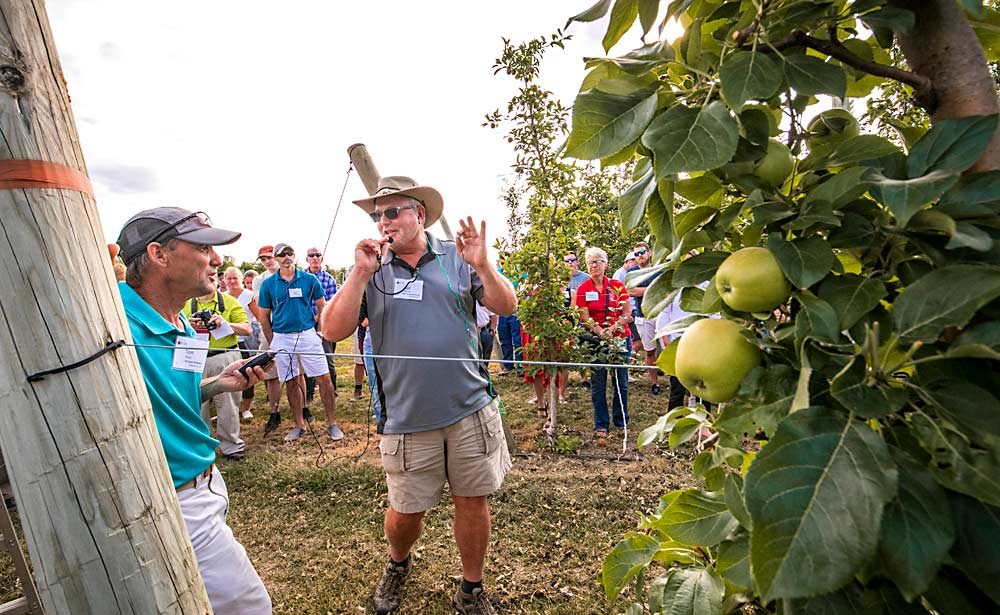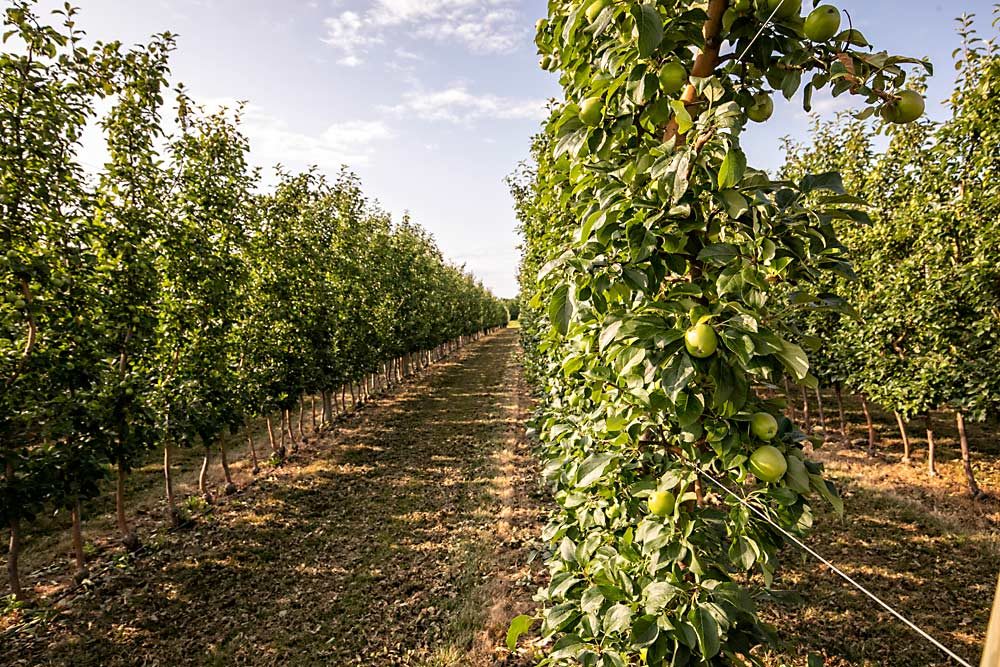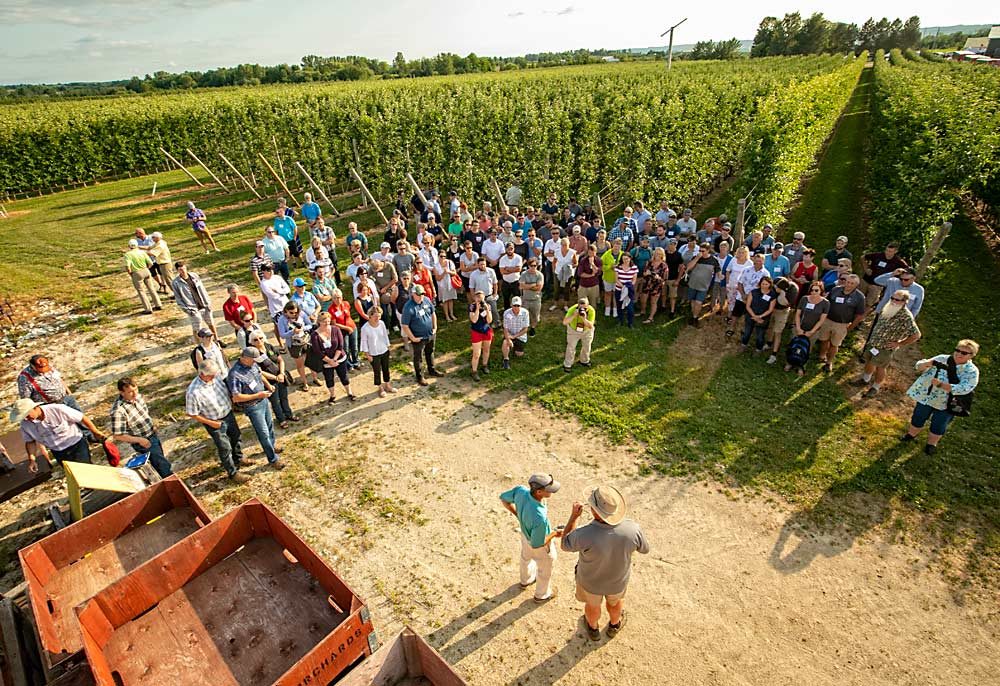
Tom Ferri grows big, beautiful Honeycrisp that command a premium price, but to do that, he needs an aggressive thinning program.
Adopting the precision crop load management model about five years ago has enabled him to be more aggressive and more confident, said Ferri, who farms 20 acres with his wife, Karen, and brother, Joe, in the Georgian Bay region of Ontario.
“We do things a little different here because for Honeycrisp, Mutsu, Cortland, we want apples that are 56s, 64s, and 72,” he said. While that’s large for most markets, his buyers at the Ontario Food Terminal in Toronto want it. “We get paid a huge premium for that.”
That means a target of 50 apples per tree, Ferri told attendees of the International Fruit Tree Association Summer Study Tour who visited his farm in July. In his super spindle systems planted at 10 feet by 18 inches, that results in about 50 bins an acre for Honeycrisp.
Precision crop load management based on the fruitlet growth model minimizes hand-thinning costs and allows him to pick premium fruit and get reliable return bloom, he said.
He’s one of only a few growers in the Ontario region using the model, which was developed by Duane Green of the University of Massachusetts, along with Terence Robinson and Alan Lakso at Cornell University and Phil Schwallier at Michigan State University.
His presentation to the tour group was a really good example of the benefits of using the model, Schwallier said afterward, and an excellent example of precision horticulture.

Crop load counts
As in any orchard, management starts with pruning, but in the Georgian Bay environment that typically offers cool nights and sunny days in September, Ferri takes a bit of a different approach, and a later harvest, than many apple growers.
“We do more summer pruning than winter pruning,” he said. “It’s our biggest job. It’s work, but it’s easy work.”
The summer pruning ensures good light penetration in his tall, super spindle blocks, but he doesn’t have to worry about sunburn risks the way growers at lower latitudes do. “We just want a narrow, narrow canopy and we want light and color,” he said.
Minimizing winter pruning also helps to control vigor, he said.
He does most of the winter pruning himself and doesn’t use bud counts — probably because after growing highly regimented super spindle blocks for almost 20 years, he can see the results he wants without counting. Ideally, he’ll have 75 to 100 buds on each tree to then thin down to the 50 fruit he ultimately wants.
His thinning program starts with NAA (naphthaleneacetic acid) and MaxCel (benzyladenine) for the first few passes, saving Sevin (carbaryl) for the last passes, he said. The fruitlet model gives him the confidence to use those sprays aggressively.
It’s an approach that helps growers plan and time their thinning sprays based on watching fruitlet development, because the fruitlets that fail to keep pace with their neighbors are destined to drop.

It sounds easy, but implementing the management model requires painstaking measurements of fruit development, which Ferri does on 14 clusters at each of five representative trees in each block.
“This model is very time-consuming, but it really does work. When you physically count the apples, what it’s telling you, if it says 82, you might be 10 above or 10 below, but it’s really accurate,” he said.
Tom’s brother, Joe Ferri, a retired engineer, handles the mathematical calculations. He’s made a few customizations to the standard model, swapping percentages for apple counts and dividing the program to look at the top and bottom of the tree separately.
“I’m using this to tell Tom what’s the largest apples that will fall off,” Joe said. “To get apples, you have to count clusters, and clusters change after every spray.”
Model vs. Mother Nature
This year, the model didn’t deliver as well as usual, and the Ferris are looking at 35 to 40 apples per tree. It was an abnormally wet, cold spring, running about two weeks behind normal with high cloud cover, unfavorable pollination weather, you name it, Ferri said.
But, three-quarters of a crop is far better than none, he added.
This year, he also experimented with adding a blossom thinning trial to the usual chemical thinning practices in a Gala block. The initial string thinning was too light, so he put on the chemical program at the regular rates, but it dropped them further than expected, Ferri said.
“They are so sensitive after you string thin,” said Rod Farrow, past IFTA president who led the group conversation.
“I didn’t believe them, but now I do,” Ferri said.

So, every year there is more to learn, but they keep records for each previous season, to look back at the model, the weather, and how their thinning program performed, to improve in subsequent years.
“Our father taught us that you can be a hero or a Charlie Brown, because chemical thinning is the most important job on the farm,” Ferri said. “I’d always rather over-thin than under-thin.”
Otherwise, it’s hard to get the big, premium fruit his specialty store customers expect. An extensive calcium program is also key to preventing bitter pit in his large Honeycrisp, which last year packed out 60 bins to the acre.
“Sixty bins is the upper limit,” he said. For Ambrosia, he can crop 60 to 70, but not Honeycrisp. “Fifty is better. I think they’d be better this year if we hadn’t overcropped last year.” •
—by Kate Prengaman






Leave A Comment